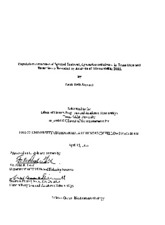| dc.creator | Stewart, Leah Beth | |
| dc.date.accessioned | 2013-02-22T20:41:05Z | |
| dc.date.available | 2013-02-22T20:41:05Z | |
| dc.date.created | 1999 | |
| dc.date.issued | 2013-02-22 | |
| dc.identifier.uri | https://hdl.handle.net/1969.1/ETD-TAMU-1999-Fellows-Thesis-S745 | |
| dc.description | Due to the character of the original source materials and the nature of batch digitization, quality control issues may be present in this document. Please report any quality issues you encounter to digital@library.tamu.edu, referencing the URI of the item. | en |
| dc.description | Includes bibliographical references (leaves 12-15). | en |
| dc.description.abstract | Variation in nuclear-encoded microsatellite loci was examined among 162 spotted seatrout (Cynoscion nebulosus) sampled from three localities in the northern Gulf of Mexico (Gulf) and one locality along the southeastern coast of Florida (Atlantic). Microsatellites are short, repetitive stretches of DNA composed of tandem repeat units. Microsatellites are thought to be ideal genetic markers for studies of population structure because they are inherited in a Mendelian fashion, highly polymorphic, and easy to amplify and score. The number of alleles at each of five microsatellite loci ranged from four to six. Significant heterogeneity in allele frequency among all samples was found at all five loci and between samples from the Gulf and Atlantic for four of the five loci. However, allele frequencies among samples from the Gulf were homogeneous. Similar results were obtained from estimates of population structure, and from estimates of genetic distance, where (dm)2 values between Atlantic and Gulf samples were five to ten fold greater than (dm)2 values among Gulf samples. These findings are consistent with previous studies of spotted seatrout where a two stock (Atlantic vs. Gulf) model has been proposed. This pattern of genetic divergence is consistent with other marine species and is thought to be attributable to historical changes in climate. | en |
| dc.format.medium | electronic | en |
| dc.format.mimetype | application/pdf | |
| dc.language.iso | en_US | |
| dc.publisher | Texas A&M University | |
| dc.rights | This thesis was part of a retrospective digitization project authorized by the Texas A&M University Libraries in 2008. Copyright remains vested with the author(s). It is the user's responsibility to secure permission from the copyright holder(s) for re-use of the work beyond the provision of Fair Use. | en |
| dc.subject | biochemistry/biology. | en |
| dc.subject | Major biochemistry/biology. | en |
| dc.title | Population structure of spotted seatrout, Cynoscion nebulosus, in Texas bays and estuaries as revealed by analysis of microsatellite DNA | en |
| thesis.degree.department | biochemistry/biology | en |
| thesis.degree.discipline | biochemistry/biology | en |
| thesis.degree.name | Fellows Thesis | en |
| thesis.degree.level | Undergraduate | en |
| dc.type.genre | thesis | en |
| dc.type.material | text | en |
| dc.format.digitalOrigin | reformatted digital | en |


